Stripped of colour but bursting with meaning, black-and-white fashion photography isn’t just an art form—it’s a revolution. From Dovima’s ethereal grace amid elephants to Helmut Newton’s bold silhouettes drenched in shadow and power, these timeless images do more than capture beauty—they challenge conventions, tell stories, and define eras. In a world of endless hues, why does monochrome remain the most compelling storyteller?

Image Source: Ed Kashi
Legendary black-and-white fashion shoots have left an indelible mark on the industry, epitomising elegance, sophistication, and artistic minimalism. One iconic example is Richard Avedon’s photograph of Dovima with elephants, shot for Harper’s Bazaar in 1955. In this image, the juxtaposition of the model’s flowing Dior gown against the elephants created a dramatic, timeless visual. The stark contrast of black and white emphasised the architectural lines of the dress and the striking poses, solidifying its status as one of the most celebrated moments in fashion history. This shoot defined high fashion’s ability to merge art with commerce and set a benchmark for how photography could evoke emotion and tell a story without the distraction of colour.
Another monumental moment in black-and-white fashion history was Helmut Newton’s provocative work in the 70s and 80s, which redefined the portrayal of femininity and power. Newton’s images, such as those for Vogue Paris, featured strong, unapologetic women in bold silhouettes, often playing with shadows and stark lighting. His ability to strip away colour and focus on form, texture, and narrative challenged traditional ideals of beauty and opened the door for edgy conceptual shoots. These images influenced fashion trends—popularising tailored suits and power dressing—and pushed photographers to explore storytelling through monochromatic palettes.
The History of Black-and-White Photography in Fashion
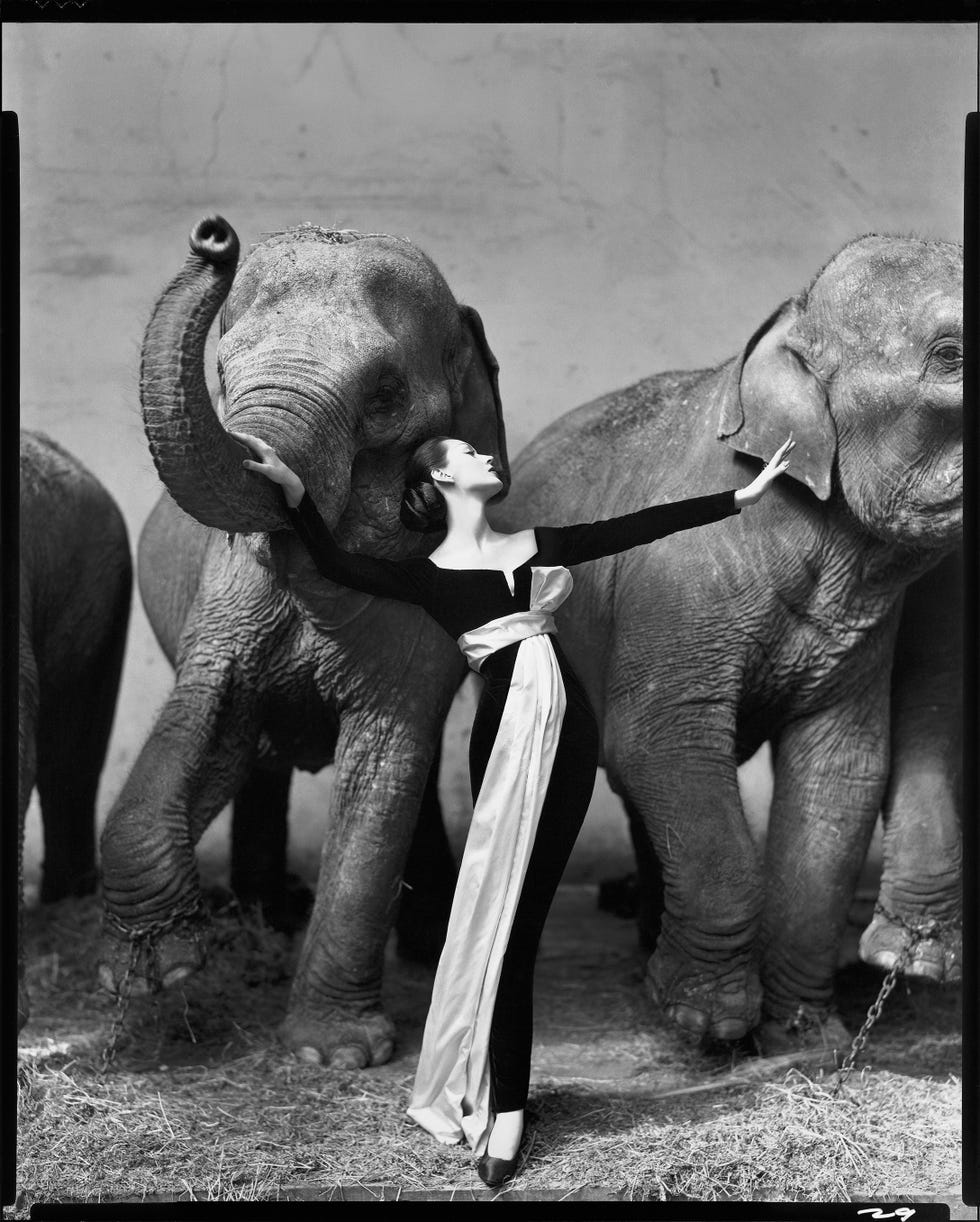
Photograph by Richard Avedon. Dovima with elephants, evening dress by Dior, Cirque d’Hiver, Paris, August 1955. © THE RICHARD AVEDON FOUNDATION
Black-and-white photography has a storied history in the fashion industry, tracing its roots to the early twentieth century when photography began to replace illustration as the preferred medium for fashion representation. Before colour photography, black-and-white images were the standard, providing a timeless, elegant way to capture apparel and accessories.
The sharp contrasts and monochromatic tones highlighted textures, patterns, and silhouettes, creating a dramatic visual language that suited high-fashion aesthetics. As magazines like Vogue and Harper’s Bazaar grew in influence, they adopted black-and-white photography to showcase haute couture, combining artistic expression with commercial appeal. This medium quickly became synonymous with sophistication and timelessness, leaving an indelible mark on fashion history.
Several legendary photographers elevated black-and-white fashion photography to an art form, shaping the industry’s visual identity. Richard Avedon revolutionised fashion imagery with his dynamic and emotionally charged portraits that brought models to life, such as his iconic 1955 photograph “Dovima with Elephants” for Harper’s Bazaar. Similarly, Helmut Newton’s provocative and avant-garde black-and-white images in the Seventies and Eighties redefined glamour and sensuality in fashion, exemplified in campaigns for Yves Saint Laurent and Vogue Paris. Their mastery of composition, lighting, and narrative elevated fashion photography beyond mere commercial work, transforming it into a compelling form of storytelling that continues to inspire generations of photographers.
Per Vogue: ’It’s an eye-opener to walk into the Tate Modern in London and come to a standstill in front of a giant blowup of a Vogue photograph by William Klein. There in all its vibrant, stripey, sixties, black-and-white brilliance is Simone + Nina, Piazza di Spagna: two models in graphic couture dresses, passing each other at a zebra crossing in Rome. It’s a page that appeared in this magazine in April 1960. To a fashion eye, it could scarcely be more resonant of precisely the trend we’ve just been watching rising through New York, London, and Paris: This season clothes have turned black and white, with a strong flavour of the sixties.…’
Classic fashion campaigns embraced black-and-white photography to evoke timelessness. Per Vogue, ‘Flash back to all those girls in black-checkered suits, dresses, and jumpsuits coming down the escalators in their little low-heeled shoes and sixties beehives at Louis Vuitton. Think of Nicolas Ghesquière’s modernised replay of Cristóbal Balenciaga’s black-and-white ruffles with a strong hint of late fifties—early sixties couture. Or Olivier Rousteing’s duotone harlequin checks and stripes at Balmain, Jonathan Saunders’s graphic stripes, and, of course, Marc Jacobs’s Op Art statement, which started it all in New York.’
Calvin Klein’s Eighties campaigns featuring Brooke Shields epitomised a minimalist aesthetic, using stark black-and-white tones to focus attention on the clothing. Similarly, luxury brand Chanel‘s campaigns under Karl Lagerfeld leaned on monochromatic imagery to convey sophistication and heritage, with campaigns like the 1991 Chanel No. 5 advertisements starring Carole Bouquet.
Per Forbes, ‘A compelling new exhibition at the New-York Historical Society traces Brathwaite’s trajectory, and his impact on African American identity through close collaboration with a group of women known as the Grandassa Models. Supplemented with his superb black-and-white depictions of the streets and nightclubs of New York, the Grandassa photographs show Brathwaite’s under-appreciated historical influence in terms that are visually timeless.’
These campaigns emphasised the purity of design and the emotional resonance of the imagery. Through such campaigns, black-and-white photography became a symbol of high fashion’s commitment to artistry and refinement.
Top 10 Iconic Photographers over the Years
Stanko Abadžić
Born in 1952 in Vukovar, Croatia, Stanko Abadžić is famous for capturing timeless everyday life in Croatia. He began his career as a photojournalist for the Croatian daily Vjesnik, producing compelling reportages from countries like Tunisia, Malta, and Turkey. However, he was forced to move overseas due to the Croatian War of Independence in 1991. Abadžić spent four years in Germany and seven years in Prague, where he transitioned from photojournalism to art photography, culminating in a retrospective at the Josef Sudek Gallery and the publication of his first monograph, ‘In the Mirror of Life’. Returning to Croatia in 2002, he reestablished himself as a photographer with his series ‘In Absentia’ exhibited at the Mimara Museum in Zagreb.
Abadžić’s work has been showcased in solo exhibits across Croatia, Germany, Portugal, and Switzerland, as well as Argentina, the United States, and Japan. Deeply inspired by masters like Henri Cartier-Bresson, Abadžić works with black-and-white film, creating images that evoke a sense of nostalgia. His artistry and dedication to the medium have earned him widespread recognition and several awards, solidifying his legacy as one of Croatia’s most influential photographers.
Ansel Adams (1902–1984)
Adams, Ansel, photographer and environmentalist, was born in San Francisco, California, and grew up in a house set amid the sand dunes of the Golden Gate. A traumatic injury during the 1906 earthquake left a permanent mark on his nose, and his family’s financial struggles following the 1907 economic panic shaped his upbringing. Despite these early hardships, Adams discovered a profound connection with nature during his youth. His first visit to Yosemite National Park transformed him, igniting a lifelong passion for wilderness photography. Equipped with a Kodak No. 1 Box Brownie camera, a gift from his parents, he began capturing the grandeur of the natural world. His deepening love for the outdoors led him to join the Sierra Club in 1919, where he served as the “keeper” of LeConte Memorial Lodge and built lasting relationships with influential conservationists.
The Sierra Club played a pivotal role in Adams’s career, providing a platform for his photography and writing. His first solo exhibit was held at the club’s San Francisco headquarters in 1928, showcasing his remarkable talent. During this time, he participated in the Sierra Club’s High Trips, where he began to his potential as a photographer. By 1934, Adams had been elected to the club’s board of directors, cementing his reputation as both an artist of the Sierra Nevada and a staunch defender of Yosemite National Park. His breakthrough photograph, ‘Monolith, the Face of Half Dome’, captured in 1927, marked the beginning of a career defined by technical innovation and artistic excellence.
A crucial turning point in Adams’s life was his meeting with Albert M. Bender, a patron of the arts. With Bender’s guidance, Adams published his portfolio, ‘Parmelian Prints of the High Sierras’. Adams also collaborated with Mary Austin on the book ‘Taos Pueblo’ and met Paul Strand, whose influence steered him toward “straight photography.” Adams became a leading advocate for this style, emphasising clarity and precision in his images while using techniques like burning, dodging, and his own Zone System to master tonal range. His work was pivotal in the formation of Group f/64, a collective of photographers dedicated to advancing straight photography as a fine art form.
Adams’s star rose steadily through the 1930s and 1940s, aided by his connection to Alfred Stieglitz and the New York art scene. Stieglitz’s support, including a one-man show at An American Place in 1936, further solidified Adams’s status as a pre-eminent artist. His photographs, rooted in the American landscape, reflected the influence of nineteenth-century painters and Transcendentalist thinkers like Ralph Waldo Emerson and John Muir. More than an artist, Adams was a tireless advocate for environmental conservation, using his images to inspire the protection of America’s wilderness.
Till date, his black and white images of America’s wilderness, particularly the Sierra Nevada Mountains and Yosemite National Park, remain unparalleled in their ability to evoke wonder and reverence for nature. Among his most celebrated works are “Monolith, The Face of Half Dome” and “Sand Dunes, Sunrise,” photographs that not only showcase his technical mastery but also his deep connection to the environments he captured.
Matt Black
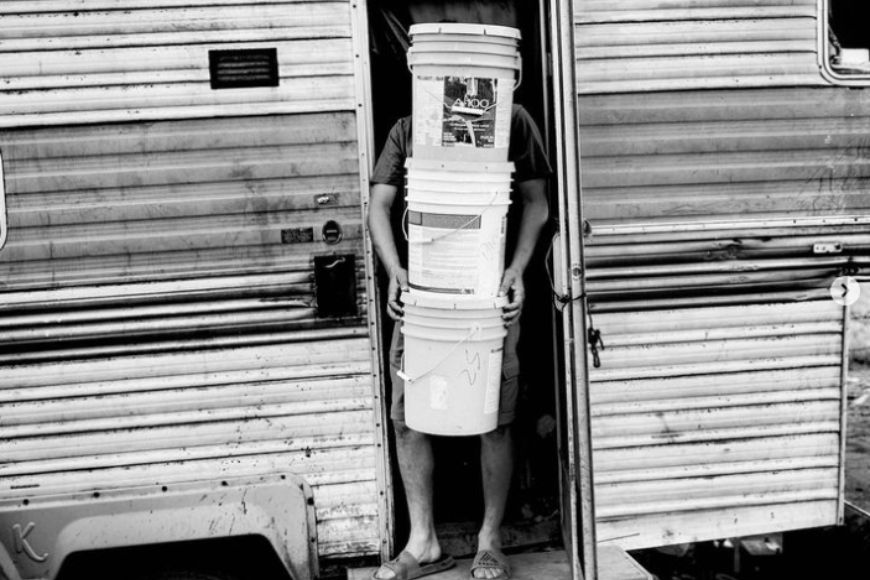
Image Source: Matt Black
Matt Black is a famous American photographer who captured black and white photos relating to poverty, migration, and inequality, hails from California’s Central Valley, a rural, agricultural area in the heart of the state. Between 2014 and 2020, he travelled across forty-six states for his project ‘American Geography’, accompanied by a traveling exhibit that opened at the Deichtorhallen, Hamburg.
Other works include ‘The Dry Land’, about the impact of drought on California’s agricultural communities, and ‘The Monster in the Mountains’, about the disappearance of forty-three students in the Mexican state of Guerrero. Both these projects, accompanied by short films, were published by The New Yorker. His work has appeared regularly in the US and international press, including TIME Magazine, The New Yorker, Le Monde and Internazionale.
Matt Black has been honoured thrice by the Robert F. Kennedy Memorial Prize, received the W. Eugene Smith Memorial Award, named a senior fellow at Emerson Collective, and is the recipient of an exploration grant from the National Geographic Society. He was nominated to join Magnum Photos in 2015 and became a full member in 2019.
Bruno Bourel
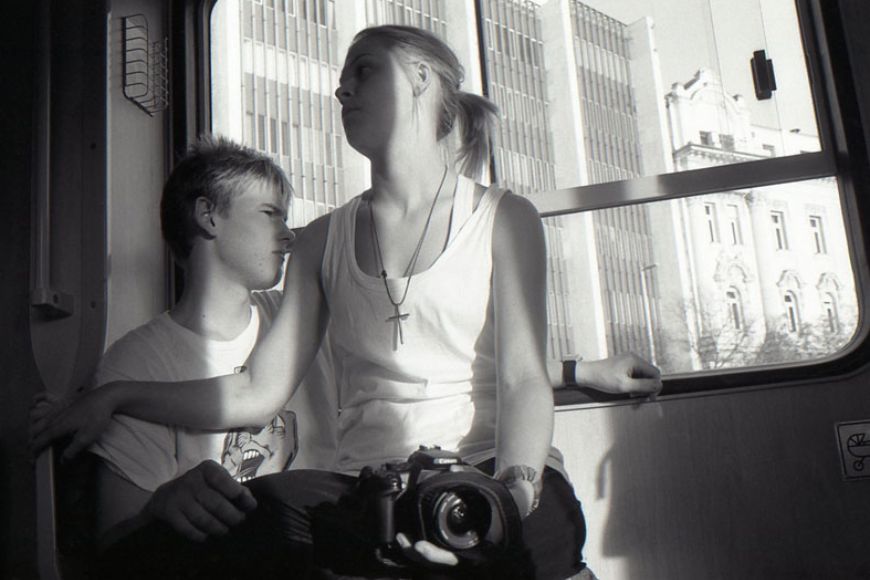
Image Source: Bruno Bourel
Based in Budapest, French photographer Bruno Bourel was born in Paris in 1957. After studying music and film making, he started photography with Polaroid SX 70 in the late seventies, capturing the raw unfiltered emotions of his subject. As his skills improved, he transitioned to a Leica camera, which allowed him to create timeless black and white portraits. He has lived and worked in Budapest since 1993.
Dirk Braeckman
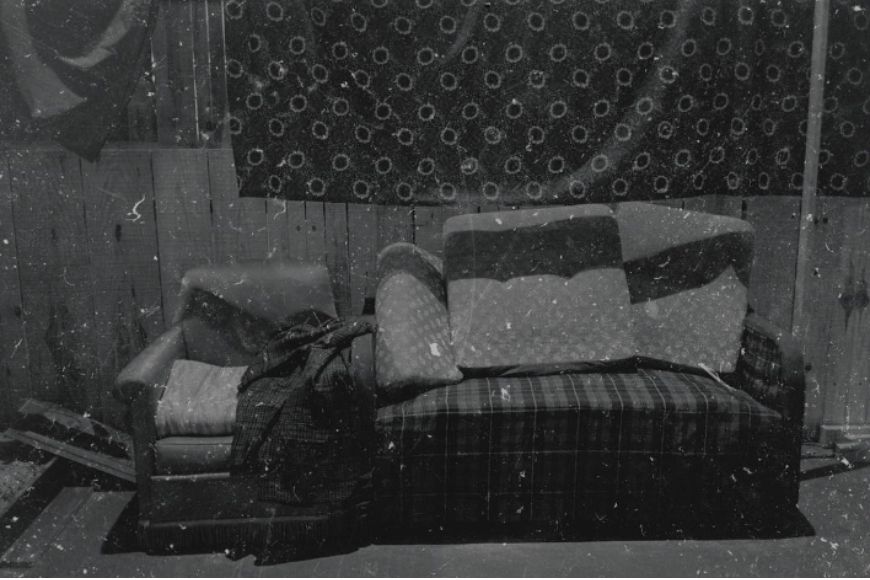
Image Source: Dirk Braeckman
Dirk Braeckman is a Belgian photographer with an enigmatic and evocative style. Since the mid-1980s, he has forged a distinctive path in contemporary photography and, recently, video art. His large-scale, gray-toned works feature subjects such as seascapes and blurred nudes, leaving space for personal interpretation. Central to Braeckman’s poetic creations are atmosphere, texture, cropping, and light, which evoke mood. His darkroom functions like a painter’s studio, serving as a space for experimentation where spontaneity shapes his creative process. By manipulating negatives with unique techniques, Braeckman infuses his photographs with a tactile quality, blurring the line between photography and painting.
Dirk Braeckman was the representative of Belgium at the 57th Venice Biennale in 2017, featuring his work “SƧƎЯЯA.” He was also included in a prestigious exhibit in Germany, ‘Documenta’, which happens every five years. In 2002 he was granted the cultural award of the University of Louvain and received the Cultural Prize of the Flemish Community, Section Fine Arts in 2005. Braeckman’s images have appeared in several magazines, books and catalogues and are housed in the Museum of Modern Art in New York, Philadelphia Museum of Art, and Bibliothèque Nationale de France.
Jane Bown (1925–2014)
English photographer Jane Bown is celebrated for her black-and-white portraits and enduring association with The Observer newspaper, which began in 1949. Her minimalist approach, relying on available light and capturing subjects with striking immediacy, earned her widespread acclaim. Described by Lord Snowdon as “a kind of English Cartier-Bresson,” Bown’s work featured notable figures, including John Lennon, Orson Welles, Samuel Beckett, Margaret Thatcher, and Queen Elizabeth II, whose eightieth birthday portrait she photographed. Preferring tools such as the Rolleiflex, Pentax SLR, and the Olympus OM-1, Bown’s portraits conveyed both intimacy and timelessness, solidifying her place as a master of the medium.
Beyond portraiture, Bown explored social documentary photography, producing compelling series on subjects such as hop pickers, the Greenham Common Women’s Peace Camp, and the Glastonbury Festival. Despite her prolific output, much of this work remained unseen until the release of her book ‘Unknown Bown’ in 2007. Her contributions were recognized in major exhibits, including ‘How We Are: Photographing Britain’ at Tate Britain. In 2014, a documentary titled ‘Looking for Light’ offered an intimate look into her life and career, highlighting her ability to connect with her subjects. Shortly before her death, Bown was awarded an honorary degree from the University for the Creative Arts, a tribute to her legacy in photography.
Édouard Boubat (1923–1999)
French photojournalist and art photographer Édouard Boubat, renowned for his evocative black-and-white imagery, was born in Montmartre, Paris. He studied typography and graphic arts at the École Estienne, later working in a printing company before transitioning to photography.
During World War II, Boubat was forced into labor under the service du travail obligatoire in Nazi Germany, an experience that exposed him to the atrocities of the war. In 1946, deeply influenced by these events, he captured his first photograph and was awarded the prestigious Kodak Prize, marking the beginning of a remarkable career.
Boubat traveled the world as a photojournalist for the French magazine Réalités before becoming a freelance photographer. Known for his humanist and apolitical approach, his work celebrated moments of beauty, joy, and peace, earning him the title of “peace correspondent” from French poet Jacques Prévert. His ability to find uplifting subjects amidst the mundane and his mastery of black-and-white photography secured his place as one of the most influential photographers of his time, a legacy that endures today.
Elliott Erwitt
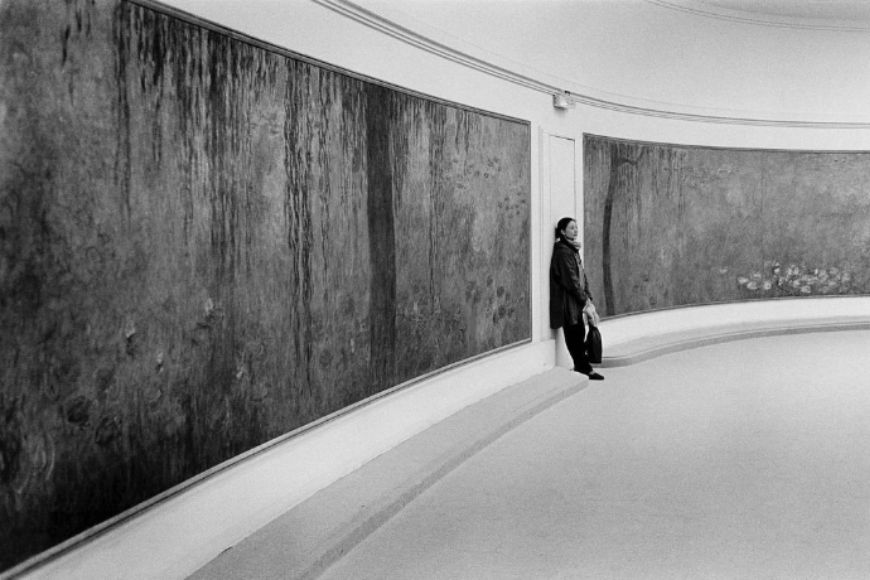
Image Source: Elliott Erwitt
Elliott Erwitt’s diverse body of work and stunning play with white photography is notable in how he infused humor and wit in his images. He is known for photographing celebrities like Marilyn Monroe, Audrey Hepburn, and Grace Kelly.
Elliott Erwitt began his career in photography during his time in the United States Army in the 1950s, serving as a photographer’s assistant while stationed in France and Germany. After moving to New York in 1948, he connected with influential figures such as Edward Steichen, Robert Capa, and Roy Stryker. Erwitt’s work soon appeared in publications such as Collier’s, ‘Look, Life, and Holiday’. In 1953, he was invited by Robert Capa to join Magnum Photos. Throughout his career, Erwitt documented significant socio-political moments, including Richard Nixon’s 1959 visit to the Soviet Union, the funeral of John F. Kennedy in 1963, and the inauguration of Barack Obama in 2009.
In addition to his photojournalism, Erwitt is celebrated for his poignant photographs of dogs, which became a recurring subject in his work and the focus of five books, including Dog Dogs (1998) and Elliott Erwitt’s Dogs (2008). He also created a satirical alter ego, André S. Solidor (“ass”), to critique contemporary photography, leading to the book The Art of André S. Solidor and a London exhibit in 2011.
Erwitt’s contributions to photography have been widely recognized; he received the Royal Photographic Society’s Centenary Medal in 2002, an Honorary Fellowship from the Society in 1994, and the International Center for Photography’s Infinity Award for Lifetime Achievement in 2011, cementing his legacy as a master of the art.
Thomas Farkas (1924–2011)
Brazilian photographer Thomas Farkas, born in Budapest, Hungary, left a lasting imprint on visual arts in Brazil. His family emigrated to São Paulo in 1930 when he was a young boy, and his father, Desiderio Farkas, co-founded the Fotoptica company, a business that would shape Thomas’s exposure to photography. While studying engineering at the University of São Paulo, Farkas gravitated toward photography, a passion nurtured by his involvement in his father’s enterprise. In 1942, he became a member of Foto Cine Club Bandeirante. During the political turmoil of the Sixties dictatorship, Farkas expanded his creative pursuits to documentary filmmaking, bringing a humanistic perspective to his work.
In 1968, Farkas joined a collective of photographers and filmmakers to document Brazil’s cultural and regional traditions, creating a body of work that reflects the richness of his homeland. Notable among his achievements is the photographic documentation of Brasilia’s inauguration, a landmark moment in Brazil’s history. In 1979, he founded São Paulo Photo Gallery, dedicated to photography exhibits. Farkas also taught photography, photojournalism, and cinema at the School of Communications and Arts at the University of São Paulo. As a documentary producer, his films, Brasil Verdade, Jânio a 24 Quadros, and Coronel Delmiro Gouveia, showcased his talent for capturing the narratives of Brazilian life.
Leonard Freed (1929–2006)
American documentary photojournalist and longtime member of Magnum Photos Leonard Freed (1929–2006) initially aspiring to be a painter. Freed discovered his passion for photography while traveling in the Netherlands, which marked the beginning of a career in visual storytelling.
After studying under Alexey Brodovitch at The New School in New York, Freed moved to Amsterdam in 1958 to document the Jewish community. Throughout the Sixties and beyond, he worked as a freelance photojournalist, capturing historical events such as the American Civil Rights Movement, during which he traveled with Martin Luther King Jr. His documentation of this era culminated in his influential book Black in White America (1968). Freed also covered other major events, including the Yom Kippur War in 1973, and later produced Police Work (1980), a deep dive into the lives of New York City law enforcement.
Freed’s talent was recognized early when Edward Steichen acquired three of his photographs for the Museum of Modern Art’s collection. In 1967, Cornell Capa selected him for the groundbreaking Concerned Photography exhibition, highlighting socially conscious photographers. Freed joined Magnum Photos in 1972 and contributed to prestigious publications like Life, Look, Der Spiegel, and The Sunday Times Magazine.
In his later years, Freed expanded his focus to Italy, Turkey, Lebanon, Germany, and the United States, producing a series of powerful photographs and directing four films for Japanese, Dutch, and Belgian television. Known for his empathetic lens and ability to humanise complex social issues, Freed left an indelible mark on the world of documentary photography.
Fan Ho (1931–2016)
Chinese master photographer Fan Ho is acclaimed for his Hong Kong Street photography since the 1950s. The photographer, film director, and actor was born in Shanghai and emigrated to Hong Kong with his family in 1949. Ho began taking photographs as a young boy, initially using a Brownie camera and later a Rolleiflex twin-lens reflex gifted by his father.
Self-taught and intuitive, Ho’s photography captured Hong Kong’s bustling streets, exploring alleys, markets, and slums with a candid yet poetic eye. His early work, developed in his family bathtub, documented the city’s transformation, as it grew into a global metropolitan hub. Across his career, Ho received close to three hundred international awards for his photography.
Ho’s artistic philosophy centered on emotional resonance and authenticity. He described his work as a means of self-expression. His compositions often combine humanistic themes with abstract forms, drawing comparisons to the Bauhaus school of design. In 2006, gallery owner Laurence Miller remarked that Ho’s works felt like “direct descendants of the Bauhaus” yet were Hong Kong in character.
Ho’s ability to combine visual abstraction with the raw essence of urban life made his photographs timeless. His talent was recognised worldwide, earning him fellowships from the Photographic Society of America and the Royal Photographic Society. Between 1958 and 1965, the Photographic Society of America named him one of the “Top Ten Photographers of the World.”
Among his most iconic works is Approaching Shadow (1954), a photograph that epitomises his mastery of light and symbolism. Taken at Queen’s College in Causeway Bay, the image features his cousin posing by a wall, with a diagonal shadow added during development to represent the passage of time and the fading of youth. The photograph’s haunting beauty and message have made it one of his most celebrated pieces, with a print selling for a record HK$375,000 in 2015. Fan Ho’s legacy as an artist lies in his ability to touch the soul, using light and shadow to craft stories that transcend time and place.
Conclusion: Black and White in Modern Fashion
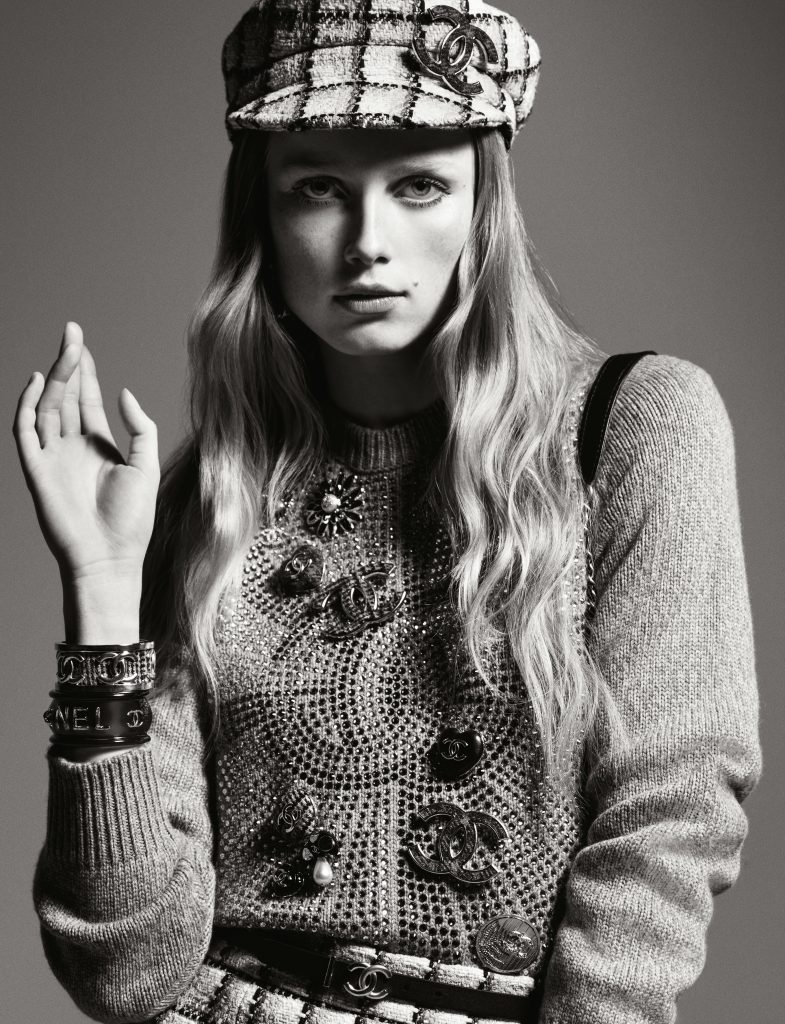
Chanel Fall Winter 2022. Image: Chanel
Contemporary photographers and fashion designers have embraced black-and-white imagery to create timeless, elegant aesthetics that stand apart from the saturation of digital media. Black-and-white photography strips an image to its core elements—light, shadow, texture, and form—allowing for a focus on the subject without the distraction of colour. In fashion, this technique emphasises the craftsmanship of garments, as seen in campaigns such as Chanel’s Fall Winter 2022, photographed by Inez and Vinoodh. The duo’s monochrome shots captured the intricate tailoring of Chanel’s pieces while evoking a cinematic allure, elevating the perception of the collection’s sophistication and heritage.
High-profile editorial shoots and campaigns have also leaned on black-and-white imagery to evoke emotion and nostalgia. Dior‘s Spring Summer 2023 campaign, directed by Elizaveta Porodina, used monochromatic portraits to create a sense of intimacy and timeless elegance. The lack of colour allowed the delicate textures of tulle and hand embroidery to shine, while the play of light and shadow enhanced the models’ expressions. Saint Laurent has frequently utilised black-and-white photography in its advertising. Their 2023 campaign featuring Hailey Bieber, shot by David Sims, embodies minimalism and rock-and-roll glamour, proving that monochrome aesthetics remain relevant in defining a luxury fashion brand’s identity.
Social media and digital platforms have also played a pivotal role in reviving the popularity of black-and-white imagery. Platforms like Instagram and Pinterest are saturated with vintage-inspired aesthetics, creating a fertile ground for fashion brands and photographers to experiment with monochrome visuals. Black-and-white photography often contrasts with the curated, colourful feed of social media, drawing attention to itself as an artistic statement.
For instance, the viral success of campaigns such as Gucci‘s “Exquisite” collection used monochrome images to amplify their reach, demonstrating that this timeless aesthetic resonates with modern audiences. Social media’s algorithm-driven emphasis on visually distinct content further encourages the use of black-and-white photography, as it often gets higher engagement due to its nostalgic appeal.
Exploring black-and-white photography is an invitation to embrace a classic art form while experimenting with modern interpretations. If you’re inspired to delve deeper into this captivating world, discover more about fashion photography and the latest trends on FashionABC. Step into the world of artistic expression, and let the timeless charm of monochrome elevate your creative vision.
Read More:
what is the fashion capital of the world
Jasmeen Dugal is Associate Editor at FashionABC, contributing her insights on fashion, technology, and sustainability. She brings with herself more than two decades of editorial experience, working for national newspapers and luxury magazines in India.
Jasmeen Dugal has worked with exchange4media as a senior writer contributing articles on the country’s advertising and marketing movements, and then with Condenast India as Net Editor where she helmed Vogue India’s official website in terms of design, layout and daily content. Besides this, she is also an entrepreneur running her own luxury portal, Explosivefashion, which highlights the latest in luxury fashion and hospitality.








